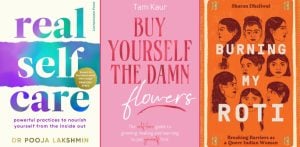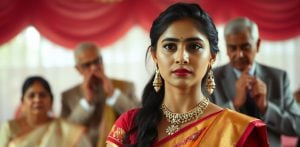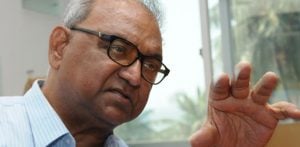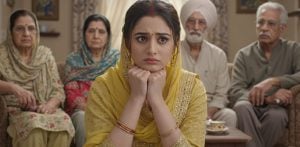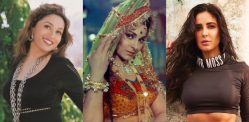Mediums reflect society, and conversely, society reflects these mediums.
DESIblitz delves into these two mediums’ origins, themes, performance styles, and cultural impacts.
Their relevance in society is apparent, especially in their advocacy to raise issues and awareness by bringing certain issues to light.
In terms of performance style, there are certainly different approaches to drama and theatre productions.
These mediums work synonymously in the sense that they both reflect society in terms of politics and female disempowerment, among other issues.
Also, society reflects these mediums in aspects such as linguistic choices and fashion in the modern day, for example.
Thus, mediums reflect society, and conversely, society reflects these mediums.
Origins of Pakistani Dramas

In terms of the origins of Pakistani dramas, they trace back to the early television broadcasting in Pakistan with the state-owned Pakistan Television Corporation (PTV) playing a pivotal role in their development.
Many Pakistani dramas are known for their compelling storytelling, nuanced characters, and ability to address social issues.
Moreover, they have a rich history that reflects the country’s cultural and social evolution.
Here’s a brief overview of the origins and evolution of Pakistani dramas, along with examples that highlight their significance:
The Pakistan Television Corporation (PTV) was launched in 1964, marking the beginning of television broadcasting in Pakistan.
It became the primary platform for airing dramas and other entertainment content, significantly influencing Pakistani culture and society.
The early dramas on PTV were simple in production but rich in narrative, focusing on social issues, family life, and moral stories.
They were usually broadcast live or recorded on tape in a single take.
This reflects the technical limitations and the nascent stage of television production at the time.
Often cited as one of the greatest Pakistani dramas, Khuda Ki Basti was based on the novel by Shaukat Siddiqui.
It dealt with social issues and the struggles of the lower-middle class, setting a precedent for socially conscious storytelling in Pakistani dramas.
Waris is a landmark drama that explores the dynamics of feudalism and its impact on society.
It is remembered for its powerful storytelling, complex characters, and portrayal of social hierarchies.
The 1980s and 1990s are often referred to as the golden era of Pakistani dramas.
These were characterised by high-quality scripts, memorable performances, and themes that resonated deeply with the audience.
This period saw the emergence of numerous classics that are cherished to this day.
A romantic drama set in a medical hospital, Dhoop Kinare was praised for its witty dialogues, charming love story, and strong performances, especially by Rahat Kazmi and Marina Khan.
Tanhaiyaan is a story of two sisters dealing with the tragic loss of their parents and their subsequent journey towards healing and hope.
Tanhaiyaan is celebrated for its emotional depth and strong female protagonists.
Ankahi is known for its humour and engaging storyline.
The Pakistani drama revolved around the life of a middle-class girl and her challenges in balancing work and personal life.
It was highly praised for its witty script and relatable characters.
With the advent of private channels in the late 1990s and early 2000s, Pakistani dramas underwent significant changes in terms of production values, storytelling techniques, and themes.
The industry saw an influx of fresh talent, innovative narratives, and a shift towards more contemporary issues.
Humsafar is a modern classic that played a crucial role in revitalising the Pakistani drama industry.
The drama captivated audiences with its intense love story, memorable soundtrack, and enticing performances by Mahira Khan and Fawad Khan.
Udaari is a groundbreaking drama that tackled the taboo subject of child sexual abuse and societal attitudes towards survivors.
It was praised for its sensitive portrayal of difficult topics and its contribution to social awareness.
The evolution of Pakistani dramas from their simple beginnings to the complex and diverse narratives of today reflects the industry’s growth.
It shows the country’s ability to adapt to changing societal norms and technological advancements.
Through their journey, Pakistani dramas have remained a mirror to society, offering insights into the country’s culture, challenges, and aspirations.
Origins of Pakistani Theatre

The origins of Pakistani theatre can be traced back to ancient and medieval times, long before the creation of Pakistan in 1947.
The roots of theatre in the region are deeply intertwined with local traditions, storytelling, and folk performances.
Over the years, Pakistani theatre has evolved, incorporating various cultural influences and adapting to changing social and political landscapes.
Here’s a brief overview of the origins and development of Pakistani theatre, highlighted with examples:
Before the partition of India and Pakistan, the region shared a rich tradition of performing arts, including classical dance, music, and folk theatre.
These performances often took place in community gatherings, religious festivals, and royal courts.
One of the most significant influences on modern Pakistani theatre was Parsi theatre, which originated in the 19th century.
It was known for its blend of music, dance, and narrative, presenting stories from Persian and Indian epics, as well as contemporary social themes.
Parsi theatre laid the groundwork for the development of Urdu theatre, which would become a foundation of Pakistani performing arts.
After the creation of Pakistan in 1947, theatre became a medium for expressing the new national identity, exploring social issues, and entertaining the masses.
The early years saw a mix of traditional performances and the emergence of a more formal, urban theatre culture.
Founded in 1984 by Madeeha Gauhar and her husband, Shahid Nadeem, Ajoka Theatre is a prime example of Pakistani theatre focusing on social issues, human rights, and peace.
Ajoka’s plays often tackle taboo subjects and challenge societal norms, making them an integral element of contemporary Pakistani theatre.
Contemporary Pakistani Theatre

Modern Pakistani theatre is diverse, ranging from classical and folk traditions to experimental and contemporary performances.
It continues to evolve, addressing current social, political, and cultural issues.
Another significant theatre group, Tehrik-e-Niswan (The Women’s Movement), was founded by Sheema Kermani in 1979.
It focuses on women’s issues, using theatre as a tool for social change and empowerment.
Through dance, music, and drama, Tehrik-e-Niswan highlights the struggles and rights of women in Pakistani society.
Katha, meaning “story” in Urdu, is a modern theatre initiative that combines traditional storytelling with contemporary themes.
It aims to make theatre accessible to a broader audience.
Often, productions are performed in public spaces.
Theatre is used to educate and engage the community on various issues.
The evolution of Pakistani theatre from its traditional roots to its contemporary form reflects the country’s rich cultural heritage.
Through its ability to entertain, educate and be thought-provoking, Pakistani theatre continues to be a vital part of the country’s cultural landscape.
It showcases the diversity and dynamic of Pakistani society.
Themes in Pakistani Dramas

Pakistani dramas are renowned for their compelling narratives, which often revolve around social issues, family dynamics, cultural conflicts, and moral dilemmas.
These themes not only reflect the complexities of Pakistani society but also resonate with audiences globally.
Here are some themes in Pakistani dramas, accompanied by examples:
Humsafar explores themes of marriage, trust, and family honour within the Pakistani context.
The story revolves around the challenges faced by the lead couple, Khirad and Ashar.
It shows how external pressures and misunderstandings test their relationship.
Udaari addresses the issue of child sexual abuse and the societal stigma surrounding the victims.
It also highlights the strength and resilience of women in the face of adversity, promoting messages of empowerment and justice.
Shehr-e-Zaat delves into the spiritual journey of a young, wealthy woman who becomes obsessed with worldly desires.
She faces rejection and learns the importance of inner beauty and humility, reflecting on materialism and spiritual awakening.
Meray Paas Tum Ho is a story that became a cultural phenomenon, exploring themes of love, infidelity, and the consequences of choices made by individuals in romantic relationships.
It sparked widespread discussion about the portrayal of women and the dynamics of marital relationships.
Among other themes, Dil Lagi touches on issues of mental health.
In particular, how personal traumas and societal pressures can affect individuals’ well-being and relationships, is a relatively less explored theme in Pakistani dramas.
These themes are a testament to the depth and diversity of Pakistani dramas, showcasing their ability to engage with complex social issues while providing entertainment.
Through their narratives, these dramas offer insights into the cultural, social, and emotional landscapes of Pakistani society, making them a significant part of the country’s cultural expression.
Themes in Pakistani Theatre

Pakistani theatre, with its rich and diverse traditions, serves as a vibrant platform for exploring a wide range of themes, from social and political issues to personal narratives and cultural identity.
The dynamic nature of live performance allows Pakistani theatre to engage deeply with audiences, often provoking thought, dialogue, and reflection.
Here are some themes in Pakistani theatre, illustrated with examples:
Bulha by Ajoka Theatre is based on the life and message of the Punjabi Sufi poet Bulleh Shah. Through his story, the play addresses themes of religious hypocrisy, intolerance, and the search for spiritual truth.
Ajoka Theatre is known for its commitment to social change and often uses historical and religious figures to comment on contemporary issues.
Aurat by Tehrik-e-Niswan focuses on the struggles and injustices faced by women in Pakistani society.
Tehrik-e-Niswan, an influential women’s theatre group, uses the medium of theatre to advocate for women’s rights, challenge patriarchal norms, and highlight issues such as domestic violence, honour killings, and gender discrimination.
Dara by the National Academy of Performing Arts (NAPA) primarily explores the historical conflict between the Mughal princes Dara Shikoh and Aurangzeb.
It also delves into themes of power, justice, and the impact of governance on the common people.
The play reflects on how historical power struggles resonate with contemporary issues of class divide and economic inequality.
Kaun Hai Yeh Gustakh by Ajoka Theatre celebrates the life and works of Saadat Hasan Manto, a renowned South Asian writer known for his candid exploration of societal hypocrisies.
The play delves into questions of cultural identity, artistic freedom, and the challenges faced by individuals who dare to speak the truth in conservative societies.
Focusing on the critical issue of water scarcity, Paani uses the medium of theatre to highlight the social, economic, and environmental challenges presented by water shortages.
The play encourages audiences to reflect on their relationship with natural resources and the importance of sustainable living.
Pakistani theatre’s engagement with these themes demonstrates its role as a mirror to society, reflecting its complexities, challenges, and the enduring spirit of its people.
Through a blend of traditional storytelling, music, dance, and modern theatrical techniques, Pakistani theatre continues to be a powerful medium for cultural expression and social commentary.
Performance Styles in Dramas

Pakistani dramas are celebrated for their rich storytelling, complex characters, and the ability to delve into the depths of societal issues.
The performance styles in these dramas are as varied as the themes they explore, ranging from naturalistic portrayals to more stylistic forms of acting.
Here are some key performance styles found in Pakistani dramas, illustrated with examples:
The performances by Mahira Khan and Fawad Khan in Humsafar are prime examples of naturalistic acting.
Their portrayal of Khirad and Ashar’s evolving relationship is grounded in realism, capturing the nuances of love, betrayal, and reconciliation in a manner that resonates with the audience in terms of their experiences.
Meray Paas Tum Ho, particularly known for its intense emotional scenes, showcases a melodramatic style of performance.
The actors, including Humayun Saeed and Ayeza Khan, deliver their roles with heightened emotions, which, while more exaggerated, effectively convey the story through an intense dramatisation.
In Udaari, actors like Ahsan Khan and Urwa Hocane immersed themselves into their characters to portray the sensitive subject matter of child abuse.
Moreover, it delves into social stigma, in an authentic and in-depth manner.
The approach to embodying a character fully in terms of its experiences, multifaceted personality and emotions was superb.
It provided a powerful realism aspect to the performance and the drama as a whole.
These examples highlight the range of performance styles in Pakistani dramas. Each drama uses a different technique to steer into a creative vision from the production team.
Whether through the subtlety of naturalistic acting or the intensity of melodramatic performances, actors in Pakistani dramas continue to captivate audiences, bringing to life stories that reflect, challenge, and entertain.
Performance Styles in Theatre

Pakistani theatre is a vibrant and dynamic form of art that encompasses a wide range of performance styles, from traditional folk and classical forms to modern and experimental approaches.
These styles reflect the country’s rich cultural heritage and the contemporary issues it faces.
Here are some key performance styles found in Pakistani theatre, along with examples to illustrate each:
Traditional performances like Tamasha incorporate folk tales, music, and dance, characteristic of rural Pakistan.
These plays often involve colourful costumes, lively music, and storytelling which is deeply rooted in the local culture and traditions.
Theatre Wallay is an Experimental theatre in Pakistan that pushes the boundaries of traditional storytelling, incorporating innovative narrative structures, multimedia elements, and non-linear storytelling.
It uses multimedia projections and interactive performances to explore themes of identity and migration, showcasing the versatility and creativity of Pakistani theatre.
The National Academy of Performing Arts incorporates physical theatre in Pakistan and explores storytelling through movement, dance, and physical expression rather than relying solely on dialogue.
The company uses contemporary dance and physical movement to convey emotions and narratives, offering a visually captivating experience that transcends language barriers.
These examples demonstrate the rich diversity of performance styles in Pakistani theatre, reflecting the country’s complex cultural landscape and its artists’ creativity and resilience.
Through these varied styles, Pakistani theatre continues to engage, entertain, and provoke thought among its audiences, both locally and internationally.
Cultural Impact of Dramas

Pakistani dramas have had a profound cultural impact, both within Pakistan and internationally, influencing fashion, language, social attitudes, and even public policy on various issues.
Their widespread appeal and accessibility through television and online platforms have made them a significant part of South Asian culture.
Here are some examples of the cultural impact of Pakistani dramas:
Humsafar not only captivated audiences with its story but also set trends in fashion.
The simple yet elegant shalwar kameez worn by Mahira Khan in the drama became a fashion statement, with women across the country emulating her style.
The drama’s popularity also influenced home decor and lifestyle products, showcasing the influence of television dramas on a variety of product consumers.
The poetic dialogues and powerful one-liners from Pyarey Afzal became part of everyday conversation among fans.
The drama’s script, penned by Khalil-ur-Rehman Qamar, was praised for its elegance and depth, influencing the way people expressed love and sorrow, and demonstrating the impact of drama scripts on language and communication.
Udaari tackled the taboo subject of child sexual abuse, bringing it to a conversational topic.
Its portrayal of the issue and the subsequent legal battle for justice not only raised awareness but also sparked debates on child protection laws in Pakistan.
The drama is credited with helping to break the silence on a topic that was previously not discussed openly, showcasing the role of media in social reform.
Meri Guriya dealt with the sensitive issue of child abuse and the murder of young girls, inspired by real-life events.
By bringing such stories to the screen, Pakistani dramas have played a role in normalising the discussion of social issues.
As well as, encouraging public discourse, and sometimes even prompting legal action or policy changes.
Through these examples, it’s evident that Pakistani dramas have a significant cultural impact, shaping societal norms, influencing trends, and inspiring dialogue on important issues.
Their stories resonate with audiences, reflecting the complexities of life and the shared human experience.
Thus, making them a powerful medium for cultural expression and social commentary.
Cultural Impact of Theatre

Pakistani theatre, with its rich tapestry of cultural narratives, traditional storytelling, and contemporary themes, has significantly influenced Pakistani society and beyond.
Its impact can be seen in various aspects of culture, social awareness, and even policy changes.
Here are some examples illustrating the cultural impact of Pakistani theatre:
Heer Ranjha by Punjab Lok Rahs among others, plays a crucial role in preserving and promoting Pakistani cultural heritage.
Through the telling of these classic love stories and folk tales, theatre aids the country for its rich literature and keeps cultural traditions alive.
These performances not only entertain but also educate new generations about their history and folklore and can allude to a sense of pride and identity.
Bulha, based on the life of the Sufi saint Bulleh Shah, tackles themes of religious intolerance and the search for spiritual truth.
By bringing such topics to the stage, Pakistani theatre encourages audiences to reflect on societal norms and inspires dialogue and action towards social reform.
Aangan Terha by Anwar Maqsood comments on the political situation and bureaucratic inefficiencies in Pakistan.
The theatre has historically been a medium for political critique and commentary in Pakistan, offering a space for playwrights and performers to express dissent and highlight issues of governance, corruption, and public policy.
Focusing on women’s issues, Tehrik-e-Niswan uses theatre to advocate for gender equality, women’s rights, and social justice.
Plays like Teesri Dastak bring stories of female resilience and empowerment to the forefront, challenging patriarchal norms and acting as an advocate for change.
This contributes to the broader dialogue on gender issues in Pakistan and empowers women by giving them a platform to share their stories.
Through these examples, it’s clear that Pakistani theatre has a profound impact on cultural preservation, social awareness, political discourse, and community engagement.
Its ability to entertain, educate, and inspire makes it a vital part of Pakistan’s cultural landscape, contributing to societal growth and transformation.
While Pakistani dramas and theatre share the common goal of storytelling and cultural representation, they differ significantly in their approach, medium, and audience interaction.
Dramas, with their broad reach through television and digital platforms, bring narratives into homes, affecting widespread public discourse.
Theatre, with its live and often interactive performances, offers a more immediate and visceral experience, allowing for a unique communal engagement.
Both forms are integral to Pakistan’s cultural landscape, each enriching the country’s artistic and social fabric in its own way.





